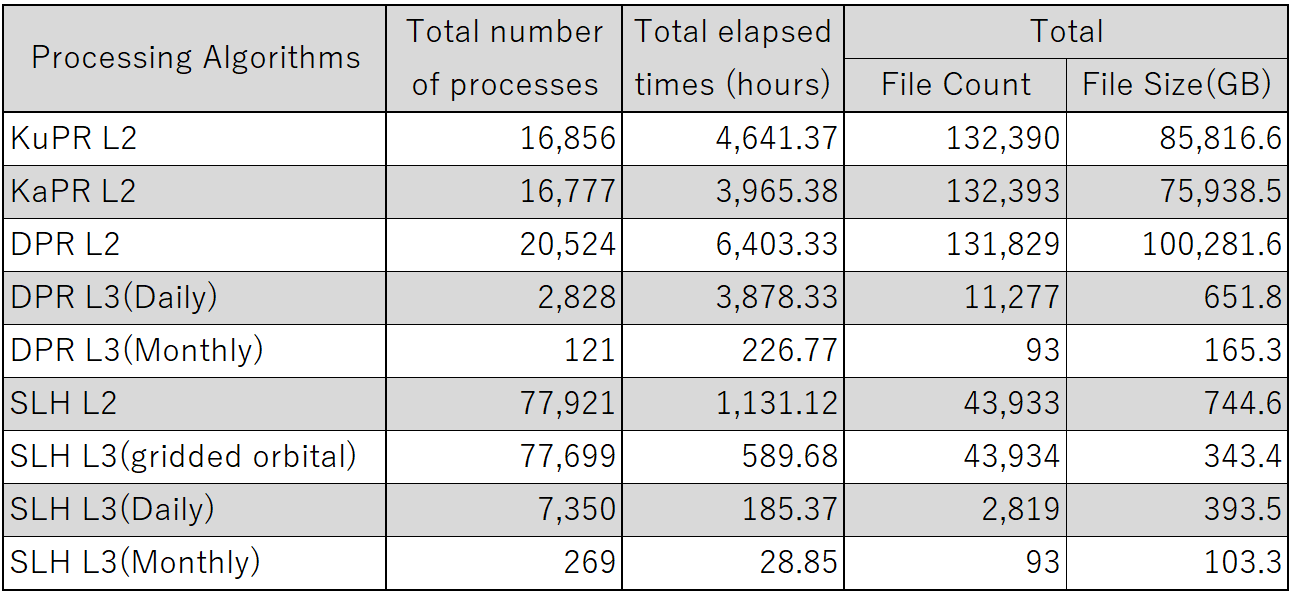Earth observation satellite data processing for GPM/DPR
JAXA Supercomputer System Annual Report February 2022-January 2023
Report Number: R22ER0200
Subject Category: Space Technology
- Responsible Representative: Takeshi Hirabayashi, Director, Satellite Applications and Operations Center (SAOC)
- Contact Information: GPM Mission Operation Officer(GPM-MOS@ml.jaxa.jp)
- Members: Masanori Toyoda, Sachiko Kawase, Masaki Yamada, Osamu Motohashi, Toshiyuki Konishi, Hisashi Tanaka, Takashi Maruyama, Yuuichi Asechi, Tomohiko Higashiuwatoko, Takeshi Masaki, Kazuhiro Sakamoto, Shinji Ohwada, Yoshihiko Tonooka, Makoto Imanaka, Yuya Hirose, Takuya Arakawa, Ashizawa Kouta, Minami, Takahiro, Yuuichirou Kitayama, Yamamoto, Tadahiro, Yukie Nakagawa, Mori, Hiroshi Kajiyama Kenichi
Abstract
In recent years, worldwide interest has been increasing about the necessity of grasping the global environmental change. To deal with such problems, various approaches using observation technology from space have been carried out by satellites.
Global Precipitation Measurement (GPM) mission, as follow-on and expansion of Tropical Rainfall Measurement Mission (TRMM) satellite, is an international mission to achieve highly accurate and frequent global rainfall observation. it is carried with multiple satellite, GPM core satellite with Dual-frequency Precipitation Radar (DPR) jointly developed by JAXA and NICT, and with GPM Microwave Imager (GMI) developed by NASA, and another constellation satellites with Microwave Imager. In addition, GSMaP (Global Satellite Mapping of Precipitation), which estimates global precipitation distribution based on data acquired by these GPM core satellites and constellation satellites, is available.
Long-term data accumulation is important to understand global environmental changes, and it is necessary to ensure continuity of data from the TRMM, which operated from 1997 to 2015, the GPM, which is currently in operation.
Reference URL
Please refer to ‘JAXA | Global Precipitation Measurement/Dual-frequency Precipitation Radar (GPM/DPR)‘.
Reasons and benefits of using JAXA Supercomputer System
Processing of earth observation data includes “operational processing” performed routinely and “re-processing” performed once a year or so for several year data. The purpose of re-processing is to correspond with version-up of computing model and algorithm performed periodically. The amount of observation data grows year by year. Then, we need more and more time to complete reprocessing of all archived observation data. By using supercomputers, the calculation time is greatly shortened, and it is possible to provide products quickly to users.
In addition, the frequency of re-processing is about once every one to two years, so the necessary period of computer resource for re-processing is limited. If this computer resource is prepared on ourselves, it is inefficient in terms of the computer utilization. The use of JSS3 is advantageous in that it can relatively flexibly secure computer resources when we needed.
In this project, the total re-processing time is reduced by increasing the number of concurrently executing processes using MPI parallel processing called “workflow control”.
Achievements of the Year
In FY2022, reprocessing of GPM/DPR L2, L3, latent heat L2, L3, and TRMM/PR L1B, L2, L3, latent heat L2, L3, and GSMaP was performed in response to the major version upgrade (V07) in December 2021. Figures 1 through 3 show a summary of reprocessing results.
Publications
N/A
Usage of JSS
Computational Information
- Process Parallelization Methods: N/A
- Thread Parallelization Methods: N/A
- Number of Processes: 1
- Elapsed Time per Case: 25.5 Minute(s)
JSS3 Resources Used
Fraction of Usage in Total Resources*1(%): 0.20
Details
Please refer to System Configuration of JSS3 for the system configuration and major specifications of JSS3.
| System Name | CPU Resources Used(Core x Hours) | Fraction of Usage*2(%) |
|---|---|---|
| TOKI-SORA | 0.00 | 0.00 |
| TOKI-ST | 1580909.62 | 1.58 |
| TOKI-GP | 0.00 | 0.00 |
| TOKI-XM | 0.00 | 0.00 |
| TOKI-LM | 1.68 | 0.00 |
| TOKI-TST | 0.00 | 0.00 |
| TOKI-TGP | 0.00 | 0.00 |
| TOKI-TLM | 0.00 | 0.00 |
| File System Name | Storage Assigned(GiB) | Fraction of Usage*2(%) |
|---|---|---|
| /home | 219.08 | 0.20 |
| /data and /data2 | 1156471.67 | 8.92 |
| /ssd | 1408.33 | 0.20 |
| Archiver Name | Storage Used(TiB) | Fraction of Usage*2(%) |
|---|---|---|
| J-SPACE | 77.86 | 0.35 |
*1: Fraction of Usage in Total Resources: Weighted average of three resource types (Computing, File System, and Archiver).
*2: Fraction of Usage:Percentage of usage relative to each resource used in one year.
ISV Software Licenses Used
| ISV Software Licenses Used(Hours) | Fraction of Usage*2(%) | |
|---|---|---|
| ISV Software Licenses(Total) | 0.00 | 0.00 |
*2: Fraction of Usage:Percentage of usage relative to each resource used in one year.
JAXA Supercomputer System Annual Report February 2022-January 2023





